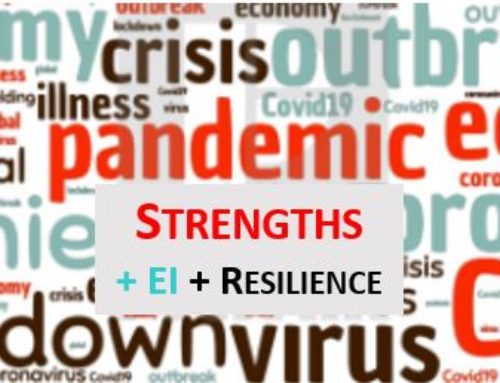My recent work with Dr. Joel Bennett has explored the benefits of aligning one’s strengths with emotional intelligence (EI) and resilience. Little did we know when we started this work two years ago that all of us would be experiencing a global pandemic with the ensuing economic tremors and challenges to the very nature of work itself. Current conditions seem to make the consideration of EI and resilience even more important.
On a practical level, there are several reasons to supplement strengths with these concepts that are in the emotional realm. For one, most strength inventories were compiled under more or less ideal conditions because they focus on peak performance. Granted there are some strength themes in which people are energized by problems, challenges and difficulties, such as Gallup’s theme of Restorative (solving problems) and the VIA character strength of Perseverance (overcoming obstacles). But in my experience, it’s a relatively small percentage of people who thrive on problems and chaos. Most of us get thrown off our game a bit (and some of us, a lot).
Difficult relationships, such as a bad boss, or challenging circumstances, such as shutting down entire industries—restaurants, travel, and lodging—often distract us from the best use of our strengths. Being in “fight, flight, or freeze” mode doesn’t set us up well for thoughtful application of our strengths. There’s a certain adaptability required under these conditions that put us squarely in the realm of EI and resilience.
I know that I’ve coached many leaders who were initially almost dismissive of strengths, saying things like, “I already know what my strengths are,” or “my strengths are what they are.” Yet these same people would be deer-in-the-headlights, “don’t know what to do next” dumbfounded when asked how they might apply their strengths to a new challenge (or even a positive opportunity outside of the scope of their past experience). So, on a practical level, it appears that strengths alone need to be supplemented with skills in the emotional realm, which we’re suggesting point to EI and resilience.
This also makes sense from a more conceptual or theoretical perspective. Most strength inventories don’t delve into the realm of emotions, EI, and resilience. Gallup’s technical report on CliftonStrengths (previously StrengthsFinder) shows that their four domains of Strategic Thinking, Executing, Relationship Building, and Influencing align with four of the “Big Five” personality dimensions—Openness to Experience, Conscientiousness, Agreeableness, and Extraversion, respectively. What’s missing? The fifth factor of Emotional Stability (sometimes labelled in the negative as neuroticism).
Likewise, the 24 character strengths and six virtues of VIA are said to correspond to the same four factors of the Big Five—not including emotional stability—by Peterson and Seligman (2004) in their Character Strengths and Virtues Handbook.
Since the Big Five factors have been shown in research to be robust and comprehensive in representing the major dimensions of individual personality, this gap in strength assessments raises a concern with how to account for the dimension of Emotional Stability. We believe the answer is EI and resilience, two well-researched concepts that clearly reside in the emotional realm of our (human) experience.
There’s more to be said about how strengths can best be aligned with EI and resilience. We believe this alignment is key to becoming your best self—in any and all circumstances—at work and in life.
© 2021, Benjamin L. Dilla, PhD
Continue Reading


Let’s Talk
If you would like additional information or have questions about coaching, team building, training workshops, or speaking engagements, schedule a free 30-minute discovery call.
Let’s Talk
If you would like additional information or have questions about coaching, team building, training workshops, or speaking engagements, schedule a free 30-minute discovery call.






